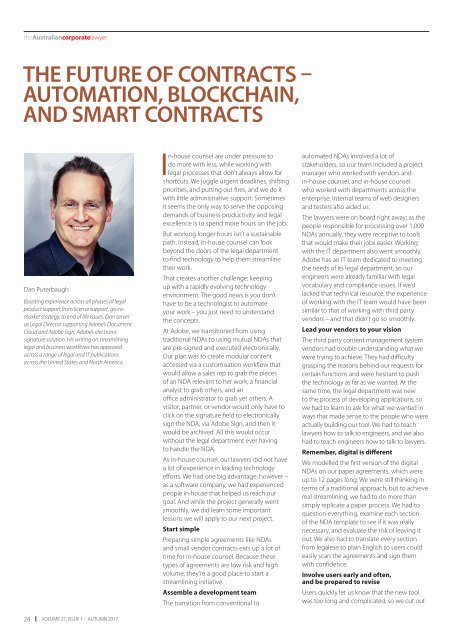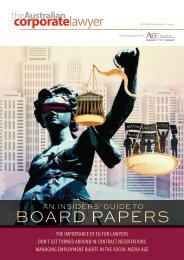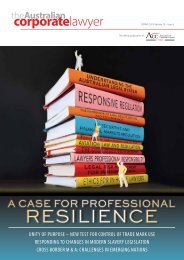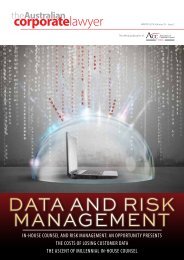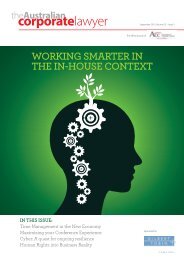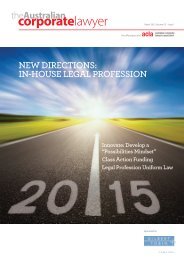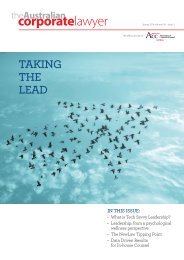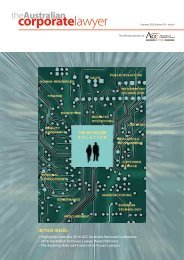Australian Corporate Lawyer - Autumn 2017
Australian Corporate Lawyer is the official publication of the Association of Corporate Counsel (ACC) Australia. The Autumn 2018 issue focuses on 'The Law and Technology' and features a range of articles covering topics including: the future of contracts and; the future of law firms as software companies..
Australian Corporate Lawyer is the official publication of the Association of Corporate Counsel (ACC) Australia. The Autumn 2018 issue focuses on 'The Law and Technology' and features a range of articles covering topics including: the future of contracts and; the future of law firms as software companies..
You also want an ePaper? Increase the reach of your titles
YUMPU automatically turns print PDFs into web optimized ePapers that Google loves.
the<strong>Australian</strong>corporatelawyer<br />
THE FUTURE OF CONTRACTS –<br />
AUTOMATION, BLOCKCHAIN,<br />
AND SMART CONTRACTS<br />
Dan Puterbaugh<br />
Boasting experience across all phases of legal<br />
product support from license support, go-tomarket<br />
strategy, to end of life issues, Dan serves<br />
as Legal Director supporting Adobe’s Document<br />
Cloud and Adobe Sign, Adobe’s electronic<br />
signature solution. His writing on streamlining<br />
legal and business workflows has appeared<br />
across a range of legal and IT publications<br />
across the United States and North America.<br />
In-house counsel are under pressure to<br />
do more with less, while working with<br />
legal processes that don’t always allow for<br />
shortcuts. We juggle urgent deadlines, shifting<br />
priorities, and putting out fires, and we do it<br />
with little administrative support. Sometimes<br />
it seems the only way to serve the opposing<br />
demands of business productivity and legal<br />
excellence is to spend more hours on the job.<br />
But working longer hours isn’t a sustainable<br />
path. Instead, in-house counsel can look<br />
beyond the doors of the legal department<br />
to find technology to help them streamline<br />
their work.<br />
That creates another challenge: keeping<br />
up with a rapidly evolving technology<br />
environment. The good news is you don’t<br />
have to be a technologist to automate<br />
your work – you just need to understand<br />
the concepts.<br />
At Adobe, we transitioned from using<br />
traditional NDAs to using mutual NDAs that<br />
are pre-signed and executed electronically.<br />
Our plan was to create modular content<br />
accessed via a customisation workflow that<br />
would allow a sales rep to grab the pieces<br />
of an NDA relevant to her work, a financial<br />
analyst to grab others, and an<br />
office administrator to grab yet others. A<br />
visitor, partner, or vendor would only have to<br />
click on the signature field to electronically<br />
sign the NDA, via Adobe Sign, and then it<br />
would be archived. All this would occur<br />
without the legal department ever having<br />
to handle the NDA.<br />
As in-house counsel, our lawyers did not have<br />
a lot of experience in leading technology<br />
efforts. We had one big advantage, however –<br />
as a software company, we had experienced<br />
people in-house that helped us reach our<br />
goal. And while the project generally went<br />
smoothly, we did learn some important<br />
lessons we will apply to our next project.<br />
Start simple<br />
Preparing simple agreements like NDAs<br />
and small vendor contracts eats up a lot of<br />
time for in-house counsel. Because these<br />
types of agreements are low risk and high<br />
volume, they’re a good place to start a<br />
streamlining initiative.<br />
Assemble a development team<br />
The transition from conventional to<br />
automated NDAs involved a lot of<br />
stakeholders, so our team included a project<br />
manager who worked with vendors and<br />
in-house counsel, and in-house counsel<br />
who worked with departments across the<br />
enterprise. Internal teams of web designers<br />
and testers also aided us.<br />
The lawyers were on board right away; as the<br />
people responsible for processing over 1,000<br />
NDAs annually, they were receptive to tools<br />
that would make their jobs easier. Working<br />
with the IT department also went smoothly.<br />
Adobe has an IT team dedicated to meeting<br />
the needs of its legal department, so our<br />
engineers were already familiar with legal<br />
vocabulary and compliance issues. If we’d<br />
lacked that technical resource, the experience<br />
of working with the IT team would have been<br />
similar to that of working with third party<br />
vendors – and that didn’t go so smoothly.<br />
Lead your vendors to your vision<br />
The third party content management system<br />
vendors had trouble understanding what we<br />
were trying to achieve. They had difficulty<br />
grasping the reasons behind our requests for<br />
certain functions and were hesitant to push<br />
the technology as far as we wanted. At the<br />
same time, the legal department was new<br />
to the process of developing applications, so<br />
we had to learn to ask for what we wanted in<br />
ways that made sense to the people who were<br />
actually building our tool. We had to teach<br />
lawyers how to talk to engineers, and we also<br />
had to teach engineers how to talk to lawyers.<br />
Remember, digital is different<br />
We modelled the first version of the digital<br />
NDAs on our paper agreements, which were<br />
up to 12 pages long. We were still thinking in<br />
terms of a traditional approach, but to achieve<br />
real streamlining, we had to do more than<br />
simply replicate a paper process. We had to<br />
question everything, examine each section<br />
of the NDA template to see if it was really<br />
necessary, and evaluate the risk of leaving it<br />
out. We also had to translate every section<br />
from legalese to plain English so users could<br />
easily scan the agreements and sign them<br />
with confidence.<br />
Involve users early and often,<br />
and be prepared to revise<br />
Users quickly let us know that the new tool<br />
was too long and complicated, so we cut out<br />
24 VOLUME 27, ISSUE 1 – AUTUMN <strong>2017</strong>


